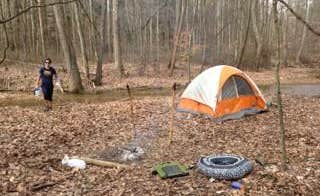Dispersed camping near Fisherville, Kentucky extends beyond the Knobstone Trail into several other wilderness areas within driving distance. The region sits at elevations ranging from 400 to 900 feet above sea level, creating diverse microclimates across the camping areas. Winter temperatures can drop below freezing while summer conditions often reach 85-95°F with high humidity levels that affect camping comfort.
What to do
Fossil hunting opportunities: The creek beds near Jackson Trailhead contain numerous marine fossils from prehistoric periods. "There are campsites along the trail just have to find them," notes camper Logan, who recommends exploring beyond the main parking area.
Backcountry navigation practice: The interconnected trail systems require solid map reading skills as some junctions can be confusing. Knobstone Trail provides excellent practice terrain for developing navigation skills. "Most people, even Hoosiers don't realize the Knobstone Trail exists," says Dave E., highlighting its under-the-radar status compared to more popular hiking destinations.
Wildlife observation: Early mornings offer prime viewing hours for white-tailed deer, wild turkeys, and numerous bird species. According to one experienced camper at Knobstone Trail, trail users should "let someone know your itinerary, have a means for filtering water, and enjoy!" This advice applies particularly well to wildlife watchers who often venture into more remote sections.
What campers like
Trail solitude: Even during peak seasons, most campers report minimal crowding on weekdays. The remoteness appeals to those seeking quiet camping experiences away from developed facilities. One visitor states the area is "very family friendly and quiet" with "spacious" sites.
Challenging terrain: Fitness enthusiasts appreciate the constant elevation changes that provide a physical challenge. The trails require decent physical condition but reward hikers with satisfying workouts. As one camper notes, "There are continuous ups and downs that will challenge your leg strength and footing at times."
Natural water sources: Small streams and springs provide filterable water along most routes during spring months. Campers appreciate access to natural water sources but should carry filtration equipment. "You're never too far from water, although the quality may differ depending on the time of year," advises a regular visitor.
What you should know
Limited parking facilities: Trailhead parking areas typically accommodate only 6-10 vehicles at most access points. Weekends can fill up by mid-morning, especially during fall colors season. One camper cautions about Jackson Trailhead: "There's parking after a decrepit gravel road and suitable for camping."
Seasonal water scarcity: Late summer brings significantly reduced water availability throughout the trail system. Hikers should plan to carry additional water during July through September. "Water can become scarce in the summer/fall months, but if you walk far enough, you're likely to come by a stream of some sort," advises an experienced backpacker.
Cell service limitations: Most of the camping areas have spotty or nonexistent mobile reception. Important communications should be handled before entering the backcountry areas. Emergency contacts should be notified of your planned route and expected return time.
Tips for camping with families
Start with shorter segments: First-time family trips work best with 2-3 mile sections between campsites. The continuous hills can quickly tire younger hikers. The area is "just beautiful" and "very family friendly" according to campers who have brought children.
Wildlife education opportunities: Bring field guides to identify common plants, birds, and insects found throughout the area. Children can create nature journals documenting species they observe during camping trips.
Weather preparedness: Summer thunderstorms develop quickly in this region. Families should pack complete rain gear and waterproof shelter options. Seasonal changes affect trail conditions significantly, with spring often bringing muddy sections.
Tips from RVers
Access limitations: The majority of camping areas near Fisherville require vehicle clearance suitable for gravel or dirt roads. Standard passenger vehicles can reach most trailheads during dry conditions. "Maybe Google Maps took me to the wrong place. I drove back and forth on the road several times looking for this place," reports one frustrated visitor, highlighting navigation challenges.
Alternative facilities: When dispersed camping proves too primitive, developed campgrounds with hookups can be found within 30-45 minutes of most trailheads. These facilities provide shower access and waste disposal between backcountry trips.
Supply planning: The rural setting means no convenient stores near most campsites. All supplies, including extra fuel and specialty items, should be purchased before arriving at trailheads.


